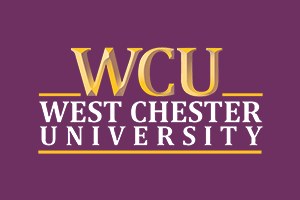All Science Poster Day Fall 2016
You all have done wonderful work to present your research! Special congratulation to Lane for winning the 1st place for graduate student poster presentations, and Cam and Stacy for winning the 2nd place of undergraduate student poster presentations! Below are some pictures from the day. A big shout out for all the students who presented their posters.
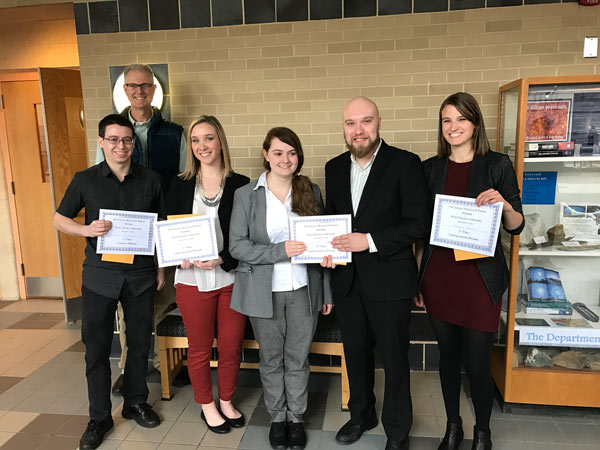
Students in the mathematics department did quite well, with Lane D’Alessandro taking first prize in the graduate student category, and Stacy Porten-Willson and Cameron Campbell taking second prize in the undergraduate student category.
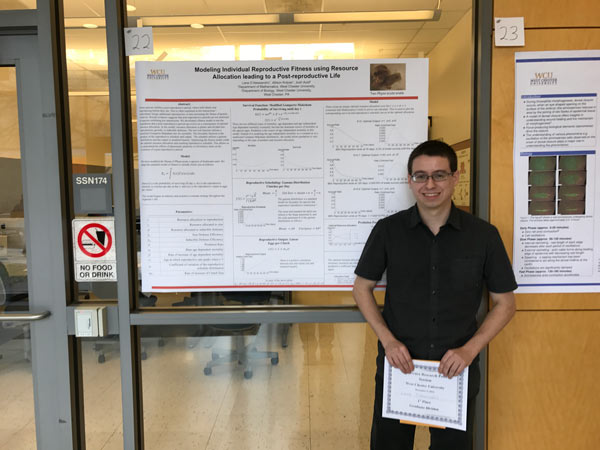
Lane D’Alessandro, a graduate student working with Dr. Allison Kolpas, received first prize in the graduate student category. Read the
abstractTitle: Modeling Individual Reproductive Fitness using Resource Allocation leading to a Post-reproductive Life
Authors: Lane D’Alessandro, Allison Kolpas, Josh Auld
Abstract: Some species exhibit a post-reproductive period , where individuals stop reproducing before they die. This is often explained as kin interactions—individuals forego additional reproduction, in turn increasing the fitness of genetic relatives. Recent evidence suggests that post-reproductive periods are not restricted to species exhibiting kin interactions. We developed a fitness model to test the hypothesis that a post-reproductive period can evolve as a consequence of optimal resource allocation. In the model, resource allocation is plastic and divided into reproduction, growth, or inducible defenses. The survival function utilizes a modified Gompertz-Makeham law for mortality. The fecundity function is the product of the reproductive schedule and output. The schedule utilizes a gamma distribution and the output is modeled linearly. Optimizing the fitness model yields the optimal resource allocation and resulting reproductive schedule. This allows us to understand the effects of phenotypic plasticity in life-history traits on the evolution of a post-reproductive period.
for Lane's poster, and another to the pdf file for the poster itself.
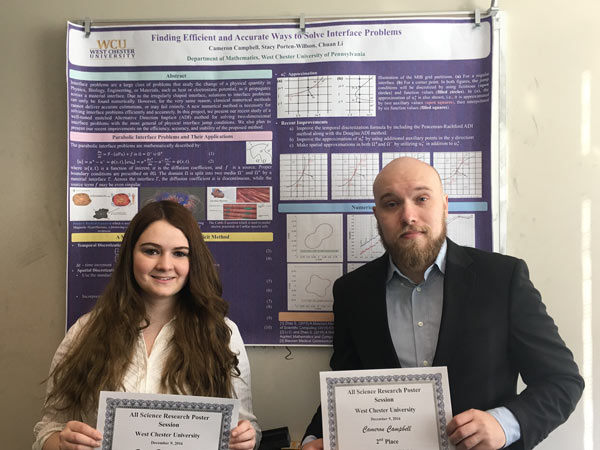
Cameron and Stacy, undergraduate students working with Dr. Chuan Li, with their winning poster. Read the
abstractTitle: Finding Efficient and Accurate Ways to Solve Interface Problems
Presented by: Cameron Campbell, Stacy Porten-Willson, Chuan Li
Abstract: Interface problems are a large class of problems that study the change of a physical quantity in Physics, Biology, Engineering or Materials, such as heat or electrostatic potential, as it propagates across a material interface. Due to the irregularly shaped interface, solutions to interface problems can only be found numerically. However, for the very same reason, classical numerical methods cannot deliver accurate estimations, or may fail entirely. A new numerical method is necessary for solving interface problems efficiently and accurately. In this project, we present our recent study of a well-tuned matched Alternative Direction Interface (ADI) method for solving two-dimensional interface problems with the most general of physical interface jump conditions. We also plan to present our recent improvements on the efficiency, accuracy, and stability of the proposed method.
for Cameron- and Stacy's poster, and to open the pdf file for the poster itself. Here is a close-up of Stacy's
award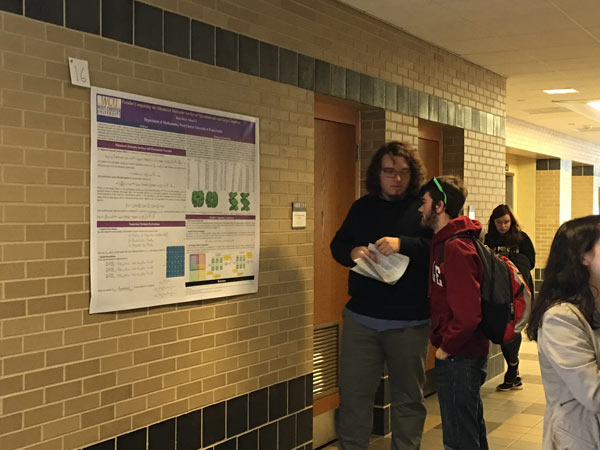
Ryan Moser, an undergraduate student working with Dr. Chuan Li, with his poster. Follow the links to open the pdf file for Ryan's poster , and also to read the
mathTitle: Parallel computing the minimized molecular surface of marcromolecules and large complexes
Presented by: Ryan Moser, Chuan Li
Abstract: Constructing the molecular surface is the first crucial stage to produce accurate calculations of electrostatic potentials and energies for the molecules immersed in the water phase. When the macromolecules and complexes consist of hundreds of thousands of charged atoms, three-dimensional surface construction becomes unbearably slow due to the high computational cost. In this project, we propose a novel grid-based computing scheme to generate the Minimized Molecular Surface (MMS) by effectively utilizing the computational power of multiple CPUs on a computing cluster via the Message Passing Interface (MPI) library. The resulting parallel code will be tested against its sequential version to demonstrate its efficiency and accuracy, and the code will be released to the computational biophysics society free-of-charge for academic usage.
.

Ben Plumridge, a graduate student working with Dr. Andreas Aristotelous, explaining the topic of his poster to another student. Here are links to the pdf file for Ben's poster , and the
abstractTitle: Development of a Model of Dorsal Closure
Presented by: Ben Plumridge, Dr. Andreas Aristotelous
Abstract: A model, based on relevant previous work, is being developed that simulates the dorsal closure process, a stage of Drosophila embryogenesis. The apical side of the amnioserosa (a cell monolayer- wound like region on the surface of the embryo) is being represented through polygonal two dimensional representations of cells, with forces acting on their edges and nodes. Those forces are being regulated by the action of actin and myosin. The model is granular enough so various sub regions can be studied to the level of the individual cell. Various equations are being tested, describing the evolution of forces generated by the action of the actomyosin network, which itself might be biochemically driven. Eventually, the model may be used to understand mechanisms of dorsal closure that are not easily analyzed in the lab or produce simulation results that might drive new experiments.}
.
